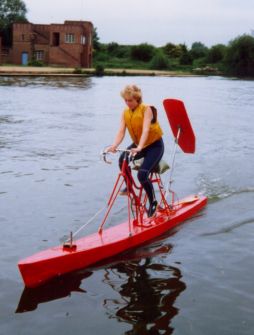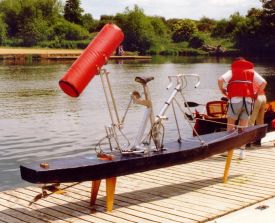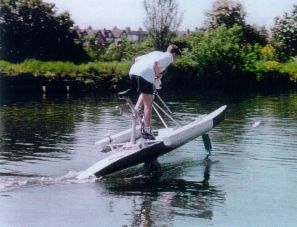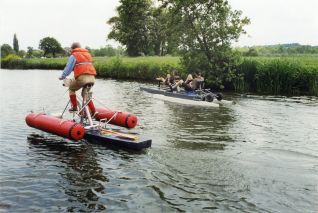| Issue 3 |
Between the years 1985 and 1999 I supervised 35 people on final-year projects relating to pedal-driven river-boats. Now, five years into retirement, it seems a good idea to report what we got up to.
Oxford has long been the home of human-powered boats driven by oars, sculls or poles, so it should be a suitable place to explore alternative ways of turning muscle power into forward motion on the water. It seemed that there might be enough engineering involved to justify undergraduate project work, and that the topic might arouse some enthusiasm. There was, and it did. The activity was inevitably a shared one, the division being roughly that I did the dynamic analysis and the wood-carving, while the undergraduates did the mechanical engineering.
The ideas behind most of the work, up to 1991 at least, were:
Dynamic analysis, and other people's experiments, show that what makes a bicycle ridable is having the steered wheel at the front, whereas most boats have the rudder at the back. So why not put the rudder at the front, and see if the rider could keep a statically unstable boat upright by steering to the right when falling to the right, and vice versa, as one learns to do on a bicycle?
For our first attempt we managed to acquire a "manufacturer's reject" windsurfer board, and mounted a bicycle frame on top, and rudder and propeller below, with a chain and home-made bevel gearbox to take the drive from the crank axle to the propeller shaft. The undergraduates were warned that they would probably need fins aft as well as a front rudder to make the vessel properly ridable, but they were perfectly happy to learn this the hard way, and did, spectacularly! With fins added, "Propedalica" (meaning "with her rudder in front") was easy to ride, though Jonathan May, one of her builders, became adept at demonstrating capsizes for the benefit of photographers. But with 0.68 m beam, she was almost statically stable, and not particularly fast. Her rapidly increasing weight, as her stuffing soaked up water, showed why the hull had been a reject in the first place.
The principle having been established, we went for something more daring. Indeed our next design was christened "Daring", and was 4 m long on the waterline, with only 0.4 m beam. The hull was thin fibreglass on top of polystyrene foam, very light, and of similar lines to a destroyer or frigate. The idea behind this was that if one does a dimensionless plot of "power-for-size" against "speed-for-size", a one-man boat comes in the middle of these naval craft, so perhaps their shape would be the optimum shape for us. Figure 1 shows her as a one-woman boat, with Joanna Coleman trying her out on the Thames, here at quite a low speed. The object on a pole behind her can be lowered either side to act as an outrigger float, if one wants to stop in midstream, or go backwards. The rudder shaft can be seen about 0.8 m back from the bow, operated by a linkage from the handlebars. Important but invisible are twin fixed fins on either side of the propeller shaft, just behind the rider (having two fins and a rudder means the boat can be stood, tripod-like, on the river-bank - most convenient). The propeller is 0.36 m diameter, right at the stern.

|
| Figure 1: "Daring" in 1988 |
"Daring" has been through many modifications since this photograph was taken in 1988. Ultimately she could do about 3.5-4.0 m/s (8-9 miles per hour), depending on who was pedalling, in a 100 m sprint. 2.2 m/s (5 mph) is a comfortable cruising speed.
It turned out that while the destroyer hull shape, sharply Vee'd at the bow, flattening towards the stern and rising to a transom, gives good speed for a given length without needing to plane, it is NOT good at tight turns with a front rudder. With a stern rudder it is fine. The bow moves in the direction it points, while the stern sideslips outwards. The gradual increase in crossflow velocity, from bow to stern, produces the centripetal force necessary to make the boat follow a circular path, and there is little force on the rudder. But with the rudder at the front, the forces are distributed very differently. The rudder has to drag this deep narrow bow sideways through the water, which needs a lot of force, and since there is little outwards sideslip, the total force it has to supply is substantially in excess of the centripetal force. If it is overloaded it stalls, so the rider loses control and the boat capsizes. A 24 m diameter turning circle was about the best we could get with "Daring", which makes the Thames, even down by the boathouses, seem a bit narrow. Our general conclusion, for any vessel, is that a front rudder gives far better control of the path taken than does one near the stern, but it won't do such tight turns.
Some interesting model experiments, and theory as above, suggested we needed a much shallower bow, and a new hull, "Skippy" (Figure 2) was built in 1989. "Skippy" managed to halve "Daring's" turning circle, to about 12 m, so we were right. She is easier to ride, though not so fast flat out, and an excellent cruising boat. Her longest one-day trip has been the 32 miles down the Thames from Oxford to Pangbourne.

|
| Figure 2: "Skippy" in 1991 |
Parts other than the hull were also being improved, many of them being made interchangeable between the "Daring" and "Skippy" hulls. We built a special-purpose frame out of aluminium tubing, a better outrigger float and an NC-machined propeller to replace the earlier ones, which had been cruder in both design and construction (Figure 2). With an electronic dynamometer on the propeller shaft to measure torque and thrust, we deduced that the "propulsive efficiency" was about 72%.
Our last effort, ultimately unsuccessful, was a pedal-powered hydrofoil. Such things had been built already elsewhere, and in 1984 one in the U.S. covered 2 km in 6m 39s, faster than the world record for a single scull. A later one originating in M.I.T., a fantastic vessel with two-stage hydrofoils and an air propeller, did 10.08 m/s (about 22.5 mph or 19.6 knots) over 100 m. Figure 3 shows ours taking off in 1998. She looks as if she is bound for the stratosphere, but in fact was flat on the water again a second later. We never did manage to get her longitudinal stability right, and she was a bit too heavy. An earlier version incorporated one of the most embarrassing engineering "howlers" I have ever had responsibility for. At that stage the "wing" had ailerons, which covered the outer three-quarters of the span, and were pivoted at their ends. What we all forgot was that when the 2 m wing flexed under the load, the ailerons would remain straight, so a great part of them was raised 10 mm or so above the trailing edge. No wonder we couldn't then get enough lift for take off!

|
| Figure 3: The hydrofoil in 1998 |
In 1997 we took "Skippy" and "Daring" to Cologne for the "Human Powered Vehicles" Championship, which included two days of boat events. There was an enormous variety of vessels there. The most spectacular was the two-man hydrofoil "Af Chapman II" from Chalmers University, Sweden. The University of Duisburg in Germany showed that one can make something simple and very fast by joining two "scull"-type hulls into a catamaran, and putting two pedallers on the centre-line, one facing left and the other right, with simple chain drives to propeller-shafts in each hull. Their latest vessel, "Close to Perfection", seemed indeed to be so, as a racing boat at least. The majority of entrants were two- or even three-person boats, which naturally gave them a speed advantage over ours, but we showed up quite well among the single-handers. We noted that the designers of the faster boats had all decided, as we had too, that the right propeller for this work looks much more like a two-bladed aeroplane propeller than the sort of thing one usually sees on boats.
Vessels similar to our displacement boats have been produced, and even marketed, in Canada and the USA, but I believe we were first!

|
| Figure 4: "Skippy" in 2004 with her new outrigger floats (photo by Tyson Rigg) |
"Daring", "Skippy" and the unnamed hydrofoil still exist, though with the Department's demands for space, they have been exiled to my garage. But I regard myself as custodian rather than owner, so if anyone would like to see them in action or try them out, they should get in touch. In the last 12 months I have arranged that either "Daring" or "Skippy" can be fitted with a pair of inflatable outrigger floats (Figure 4). These are normally clear of the water so do not affect the speed, but prevent capsize, at least for a rider of up to about 80 kg, who can stop in midstream and lean on one. They undoubtedly enhance the confidence of a senior-citizen rider, and possibly of a beginner too. And the gear-ratio has been lowered, to a value more suitable for cruising than for sprinting.
Cruising a river in these boats has its charms. It does not take much effort to maintain 5 mph, the speed-limit for powered boats on the Thames, so one can cover a good distance; one is facing forward (unlike a rower), and high up (unlike a canoeist), so the view is good; and there is little noise to disturb the wild-life.
I owe thanks to the Department's Project Committee for letting me run these projects, and to the Workshop for the enthusiasm with which they helped the undergraduates build the boats.
[A fuller account of the displacement boats appeared in "Human Power", Vol 13.1, 1997]
| << Previous article | Contents | Next article >> |
| SOUE News Home |
Copyright © 2004 Society of Oxford University Engineers |
SOUE Home |